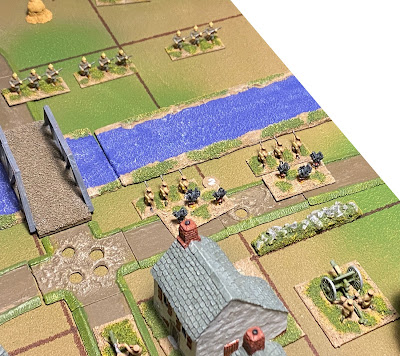On the day before the 110th anniversary of the Battle of Mons (23rd August), Nick Huband refought the battle on a 6 x 6 square grid using his World War I adaptation of the Portable Wargame rules. He shared the following description of the wargame on the Portable Wargame Facebook page as well as the photographs featured below.
I used the 'Over The Top' rules in the Second Portable Wargame Compendium with a few tweaks; if a square is attacked by a single unit, every unit in the square is attacked simultaneously (this reflects the punishing effect of "bunching"), rifle range is two squares and I left out the reserve areas as they're not really needed in the early encounter battles. The 6 x 6 board is a very condensed version of the battlefield with the Mons-Conde canal running across the centre of the board and the town of Mons on the right.
The opposing forces were similarly condensed with twelve battalions (stands) of German infantry, two of Jaeger and two of cavalry, supported by four stands of artillery and three of machine guns. The British forces comprised ten battalions of infantry, three stands of artillery and one machine gun stand. The stretcher bearers, dressing station, and despatch rider are just eye candy! Strength points were 70 SPs for the Germans and 45 SPs for the British. The length of the game was set at 10 turns.
The Germans representing the 18th Division of Kluck's First Army arrived from the north sequentially and deployed to assault the canal and bridge on the British right. On turn 4, Jaeger and Cavalry arrived to threaten the British left flank (the cavalry were dismounted as I haven't got any suitable German cavalry on foot).
The action proceeded much as the actual action, a grinding advance by the Germans to reach the canal with both sides suffering from rifle and artillery fire (I'm beginning to understand the value of good artillery preparation!).
By turn 7 the Germans had crossed the bridge and there was fierce fighting in the town. On the other flank after a lengthy exchange of fire across the canal, the dismounted German cavalry finally rushed across the bridge threatening, the British left flank.
By turn 9, towards the end of the day, the Germans were gaining the upper hand in the street fighting and the British had reached their exhaustion point and broke off the action. Casualties were 33 SPs for the Germans and 24 SPs for the British. This is very close to the estimated casualty ratio based on 1,600 British casualties and some 2,000 German casualties (based on analysis of German records - and not by Terence Zuber). Also the game took 9 turns, just under a day (10 turns) just as it did historically. This gives me some confidence in the effectiveness of the rules.
The start of the action with the Germans just coming into view.
The Germans start to deploy.
British defenders of the canal under shellfire.
The German attack developing with the cavalry and Jaeger coming up on the left.
The German attack developing with the cavalry and Jaeger coming up on the left.
Hand-to-hand fighting in the town.
Fighting on the left flank.
The struggle for the town continues until the British reach their Exhaustion Point and break off the action.
Please note that photographs featured above are © Nick Huband.








































I do like Nick's terrain. Didn't he do some PW Chaco and SCW games that looked really nice?
ReplyDeleteNeil
Neil Patterson (Neil),
DeleteYou are absolutely right! The relevant battle reports can be found at https://wargamingmiscellany.blogspot.com/2011/11/portable-wargame-in-chaco.html and https://wargamingmiscellany.blogspot.com/2012/08/the-portable-spanish-civil-war-wargame.html .
All the best,
Bob
Fantastic looking game! Thanks for sharing this Bob.
ReplyDeleteMaudlin Jack Tar,
DeleteIt is a very impressive-looking battle.
All the best,
Bob
A great battle report and beautiful game. Makes me want to start exploring Great War games.
ReplyDeleteMark Cordone,
DeleteNick has some very impressive armies of Peter Laing figures as well as being a very talented terrain modeller. The mobile phases of the Great War are much neglected by wargamers, which is a great pity as there are lots of interesting actions that can be fought.
All the best,
Bob
That is a very nice terrain set up.
ReplyDeleteRob Young,
DeleteNick's terrain is always simple and elegant. I think that he uses a combination of subtle green and brown spray paint to get the mottled effect on his terrain boards.
All the best,
Bob